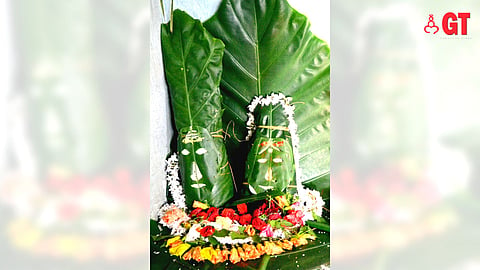

If one had to ask you, what’s the most important part of the Ganesh Chaturthi festival, apart from the Ganesh idol (which is made of river clay) and the matoli (wooden canopy suspended above the Ganesh idol, which is decorated with seasonal flora)?
I’m sure most of you are wondering what else could possibly be important? It is nothing, but a bunch of wild leaves, which are integral to the Ganesh puja or pujan. Locally, this bunch of wild leaves is known as patri and is offered to Lord Ganesh on the day of Chaturthi.
These leaves are of different shapes, sizes and medicinal properties, and are clubbed together to offer to deities. Ideally, they are collected by the villagers from their backyards and forests.
Each of these leaves are highly medicinal, some are rare and describe the seasonal biodiversity of the land.
A GALAXY OF LEAVES
If we look minutely, these leaves and the celebration of biodiversity as a whole, is what the festival of Ganesh Chaturthi is all about.
It starts with the festival of Tay or Hartalika puja, which is usually held a day before Chaturthi, which is dedicated to goddess Parvati, as there is a custom of worshipping Lord Mahadev and Goddess Parvati — parents of Lord Ganesha — during Chaturthi.
Lord Mahadev is symbolized by a coconut and goddess Parvati by the yellow flowers of Harna or Sonki. These flowers bloom at this time of the year, usually on plateaus.
However, in some villages of Canacona, a bundle of wild leaves known as pudi is worshipped as Parvati. This bundle consists of leaves and flowers of impatiens locally known as chiddo, leaves of areca nut, fronds of the coconut palm, tulsi, and also paddy leaves. All these leaves are then wrapped in kasal leaves (Alocasia Calidora).
Also, in the village of Mashem, masks of Shiva and Parvati are made from kasal or alocasia leaves, and are decorated with white leaves from the dhobi’s tree (Mussaenda frondosa).
On the day of Chaturthi, there is a ritual of offering 21 different types of wild leaves to Lord Ganesha. The number 21 is considered auspicious for Ganesh puja as there’s also a tradition of offering 21 strands of durva (Cynodon dactylon).
It is believed that the one who performs the puja has to collect 21 different flowers and leaves and offer them with 21 different names of Ganesha. This bunch of leaves is known as patri.
Some of these leaves are Bel/Bilvapatra (Aegle marmelos); Tulsi (Ocimum Tenuiflorum); Nirgundi/Bramhi (Centella asiatica); Waterlily (Nymphaea nouchali); Rui (Calotropis gigantea); Rose (Rosa sp.); Vad (Ficus benghalensis); Parijatak/Parijat (Nyctanthes arbor-tristis); Ber/Badri (Ziziphus jujuba); Bringaraj (Eclipta prostrata); Durva (Cynodon dactylon); Shami (Prosopis cineraria); Kaner (Cascabela thevetia); Kevada (Pandanus odorifer), Jati-Jasmine; Datura. These leaves are then wrapped in the leaves of Arjun tree (Sterculia urens).
However, nowadays due to urbanisation, destruction of laterite plateaus, it is difficult to find some species like Suryakant (Indigofera dalzellii) and Shivkant (Crotalaria sp.).
It is important to note that all these species have medicinal value and that’s why they are part of our rituals as it is the traditional way of educating the younger generation about the local biodiversity.
That’s not all. Even for the matoli, a bunch of mango leaves are used. These are an integral part of the matoli.
Sadly, as we are now getting disconnected with nature, it is becoming more and more difficult for us to identity and gather these leaves. We now buy this patri from markets, without even understanding what these leaves are and why they are used for rituals.
So, as we celebrate one of Goa’s biggest festivals today, let’s try to understand these rituals, and get the real meaning of this festival which teaches us about our biodiversity in a most creative way.